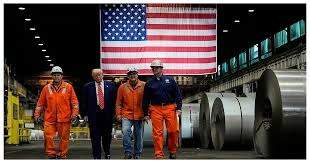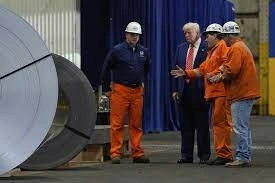Trump’s Tariffs Cast a Shadow on Engineering Goods Exports from Delhi’s Industrial Belt
In the heart of Ghaziabad, a bustling industrial hub near Delhi, a paradox of modern manufacturing plays out every day. Inside one of the city’s cavernous factory sheds, a giant forging machine—sleek, powerful, and imported from China at a staggering cost of Rs 20 crore—stands silent. Its steel frame, once expected to usher in a new era of precision and scale, now gathers dust under the dim glow of factory lights.

This machine, meant to be the future of engineering exports, is idle. In its shadow, a much older scene unfolds: workers in sweat-soaked shirts, sleeves rolled up, hammering molten metal with rhythmic precision. The steady clangs of iron striking iron echo like the heartbeat of an earlier era.
For CD Industries, a Ghaziabad-based manufacturer of metal flanges supplied to oil and gas exploration rigs in the US, the silent machine is more than an unused investment—it is a symbol of uncertainty brought on by Donald Trump’s tariff policies.
The Rise and Pause of Modernization
The forging machine was supposed to transform CD Industries. With electric-powered efficiency, it could shape metal components faster, better, and at a larger scale. It was meant to replace the slower, labor-intensive methods of the past and help Indian exporters meet the evolving demands of overseas clients.
But today, instead of progress, the machine represents hesitation. Why? Because Trump’s tariff war has clouded the future of Indian exports, particularly in the engineering goods sector.
Trump’s Tariffs: A Roadblock for Exporters
The U.S., one of India’s largest markets for engineering goods, has become a difficult destination. Under Trump’s economic strategy, tariffs on imported goods have been steadily raised in the name of “protecting American industries”.
For Indian exporters, this means:
- Higher costs for shipping products into the U.S.
- Reduced competitiveness against local American manufacturers.
- Uncertainty in contracts, as buyers hesitate to commit to long-term deals.
For companies like CD Industries, which relies heavily on U.S. clients, the tariffs have forced a painful pause. The brand-new forging machine sits idle not because of technical flaws but because orders have slowed down, making the investment risky to fully deploy.
The Human Side of the Crisis
While machines gather dust, workers still keep the factories alive. In Ghaziabad, hundreds of laborers continue using traditional presses, crafting components manually. Their sweat and rhythm keep production going, but even they know that the volume of orders has shrunk.
For many families dependent on factory wages, Trump’s tariffs are not a distant geopolitical issue—they are an everyday worry. Fewer exports mean fewer shifts, and fewer shifts mean tighter household budgets.
India’s Engineering Export Boom—and the Sudden Chill
Over the last two decades, India’s engineering goods sector has grown rapidly, driven by global demand for cost-effective and high-quality components. From flanges and valves to machinery parts, Indian factories became vital suppliers for industries ranging from oil and gas to automobiles.
Ghaziabad, Faridabad, and Noida became thriving hubs feeding international supply chains. Companies invested in automation and advanced technology to stay competitive.
But tariffs under Trump have disrupted this upward curve. Instead of expansion, many exporters are now in survival mode—cutting costs, delaying investments, and waiting for clarity.
The Bigger Picture: Trade Wars and Uncertainty
The issue goes beyond Ghaziabad or CD Industries. Trump’s tariff policies are part of a broader trade war strategy, primarily aimed at China but affecting multiple countries, including India.
Key impacts include:
- Disrupted supply chains – Companies that once relied on smooth imports and exports now face sudden cost escalations.
- Investment hesitation – Manufacturers are holding back on capital expenditure due to market unpredictability.
- Global competitiveness – Countries like Vietnam and Mexico are stepping in to fill gaps left by India, capturing U.S. contracts.
This uncertainty is particularly damaging for small and medium enterprises (SMEs), which lack the financial cushion to withstand prolonged downturns.
Ghaziabad’s Factories at a Crossroads
Factories in Ghaziabad reflect the crossroads at which India’s industrial belt finds itself:
- Old vs. New – Workers using decades-old presses continue side by side with shiny, high-tech machines waiting to be powered on.
- Hope vs. Fear – Business owners dream of global expansion but worry about unstable trade policies.
- Local vs. Global – While local demand exists, it is not enough to replace the scale of U.S. exports.
The forging machine in CD Industries’ shed is not just a piece of equipment—it is a symbol of this delicate balance between ambition and uncertainty.
What Lies Ahead?
The future of India’s engineering exports depends on several factors:
- U.S. Tariff Policy – If Trump continues his aggressive tariff approach, exporters will need to explore alternative markets in Europe, Africa, and Asia.
- Diversification – Relying heavily on one market (like the U.S.) has proven risky. Companies may need to diversify their export destinations.
- Government Support – Indian exporters are calling for subsidies, tax reliefs, and diplomatic efforts to counter trade barriers.
- Innovation – Even amid uncertainty, companies must continue investing in technology to stay competitive in the long term.
A Silent Giant, A Loud Message
Back in the Ghaziabad shed, the contrast remains stark: the massive, idle forging machine and the clang of workers’ hammers. This scene tells a larger story about India’s industrial belt—caught between global ambitions and political realities.
Trump’s tariffs may have dimmed the outlook for engineering goods exports, but they have also highlighted a crucial lesson: the need for resilience, adaptability, and diversification in global trade.
For now, the giant machine waits in silence. Whether it will roar to life soon depends not only on the decisions made in Ghaziabad but also on the policies being shaped in Washington, D.C.
Follow us for more news at Valleynewz.com

